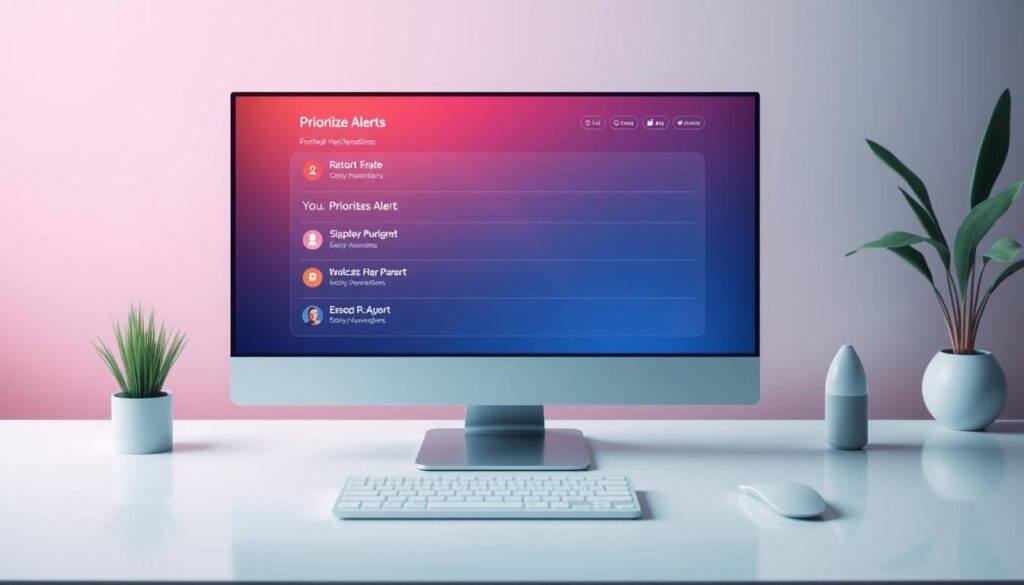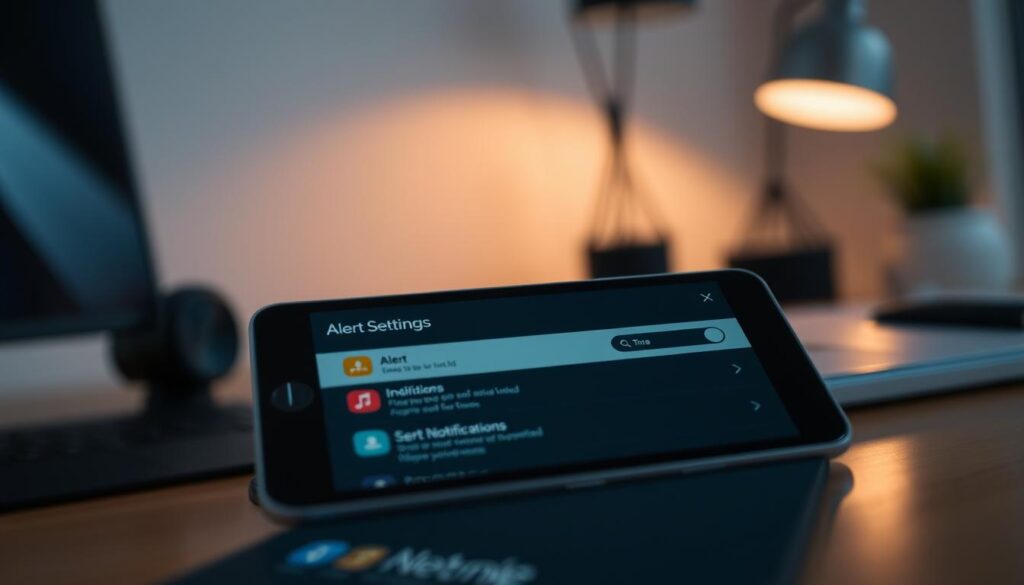In today’s digital world, our devices are always buzzing with alerts. These can be helpful, but too many can be overwhelming. That’s where the “hide alerts” feature comes in. It lets users control their notifications and find a balance between staying informed and staying focused.
Dealing with alerts and notifications can be tricky. It’s important to understand how they work and how to manage them. This article will explain what “hide alerts” means, how it works, and how to handle too many notifications.
Key Takeaways
- Understand the purpose and importance of alerts in digital devices
- Learn when and why to hide or suppress notifications
- Discover strategies for prioritizing important alerts and customizing notification settings
- Explore the benefits of managing notification overload for improved focus and productivity
- Gain insights on how to strike a balance between staying informed and minimizing distractions
Demystifying the “Hide Alerts” Function
The “hide alerts” function is a powerful tool for managing digital distractions. It helps you stay focused by blocking unwanted notifications. Knowing when to use it is key to balancing convenience and staying informed.
Understanding the Purpose of Alerts
Alerts notify you of important updates and events. They can be messages, reminders, or software updates. But too many alerts can be overwhelming and hurt your productivity.
When to Hide Alerts: Balancing Convenience and Awareness
Deciding to hide alerts, disable alerts, or turn off alerts depends on your needs. Sometimes, hiding alerts helps you focus. Other times, you need to stay updated with important alert settings.
For example, during a big work project, hiding alerts can help you concentrate. But, keep important alerts like emergency messages visible. This way, you won’t miss critical information.
By finding the right balance, you can improve your digital experience. The “hide alerts” function helps you manage notifications. This way, you can stay productive and focused.
What Does “Hide Alerts” Mean?
The “hide alerts” function on your device helps manage the flood of notifications. It blocks the visual and sound cues from messages, app updates, and alerts. This is great when you need to focus without interruptions.
Choosing to hide alerts doesn’t mean you’re missing out on important info. It lets you mute or dismiss alerts temporarily. Then, when you’re ready, you can check your notifications to see if anything important needs your attention.
- Hiding alerts reduces notification overload and cuts down on distractions.
- It lets you temporarily silence alerts without turning them off forever.
- Hiding alerts gives you more control over your device’s alert settings.
Understanding the “hide alerts” feature helps you balance staying informed and staying focused. It’s a key tool for customizing your notification preferences. It makes your digital experience more peaceful and productive.
Managing Notification Overload
In today’s world, we face a flood of notifications from our devices. These alerts aim to keep us updated, but they can quickly overwhelm us. This is known as “notification overload.” Luckily, we can manage these alerts to stay informed without getting distracted.
Prioritizing Important Alerts
The first step is to sort out the most important alerts. Not all notifications are created equal. It’s key to know which ones are vital and which can wait. Here’s how to focus on what’s most important:
- Find the alerts that matter most, like work updates, urgent messages, or key app news.
- Turn off alerts for less important stuff, like social media or gaming updates.
- Adjust your alert settings to mute or suppress alerts from apps or contacts that aren’t essential.
- Look into ways to block or dismiss alerts that are often irrelevant or distracting.
By focusing on the most critical alerts, you can stay updated on what’s important. This reduces distractions from less vital notifications.
| Alert Type | Importance Level | Recommended Action |
|---|---|---|
| Work-related updates | High | Keep alerts enabled |
| Urgent messages from loved ones | High | Keep alerts enabled |
| App updates | Medium | Customize alert settings |
| Social media notifications | Low | Disable or mute alerts |
| Gaming notifications | Low | Disable or mute alerts |
By using these strategies, you can manage your alerts better. This helps you stay informed about what’s important without feeling overwhelmed by too many alerts.

Customizing Alert Settings
In today’s world, our devices send us many notifications. These alerts are meant to keep us updated and connected. But, they can also be too much. Luckily, smartphones let us change alert settings to manage them better.
The “Hide Alerts” feature is very helpful. It lets you mute notifications from certain chats. This way, you can ignore distractions and focus on what’s important without stopping all alerts.
Your device’s settings have many options for managing alerts and customizing alert preferences. You can disable alerts for certain apps, suppress alerts at specific times, or block alerts from certain contacts. By adjusting these settings, you can dismiss alerts that don’t matter and prioritize the notifications that do.

Finding the right balance is key. Try different alert settings to see what works best for you. Whether you want to hide notifications, turn off alerts, or just manage your alerts better, you have the tools to control your digital life and avoid too many alerts.
Conclusion
The “hide alerts” function is a great way to handle too many notifications. It helps us manage our digital lives better. By knowing when to hide alerts and how to set up our devices, we can focus on what’s important.
If you want to disable alerts, turn off alerts, mute alerts, suppress alerts, block alerts, or manage alerts better, this article has you covered. It shows ways to find a balance between staying updated and avoiding too many notifications.
Understanding what does hide alerts mean and how to hide notifications is key in today’s tech world. By adjusting your alert settings, you can concentrate on what’s essential. This makes you more productive and gives you a smoother digital experience.
FAQ
What does “hide alerts” mean?
“Hide alerts” lets you stop notifications and alerts on your devices. This includes phones, tablets, and computers. It helps you focus by reducing distractions and controlling what you see.
When should I hide alerts?
Hide alerts when you need to focus, like during work or study. It’s also good when you’re trying to avoid too many notifications. Or when you just want a break from digital stuff.
How do I customize my alert settings?
Most devices and apps let you change alert settings. You can mute or block certain alerts, or set how often you get them. Looking into your device’s or app’s settings can help you find a good balance.
How can I manage notification overload?
First, figure out which alerts are really important. Then, hide or turn off the rest. Use your device’s “do not disturb” or “focus mode” to cut down on distractions.
What happens when I hide alerts?
Hiding alerts means you won’t see notifications on your screen or hear them. They’re not gone forever, though. You can check them later in your notification center or history.







1 thought on “What Does Hide Alerts Mean? Understanding Notifications”